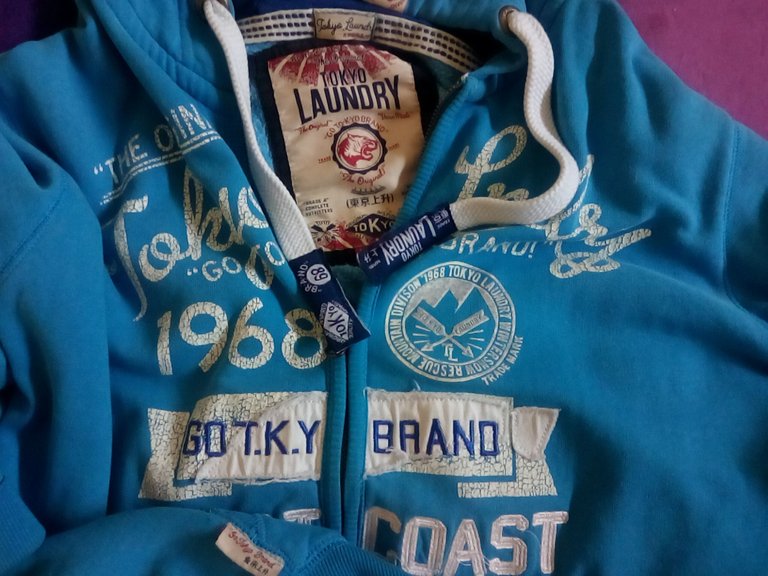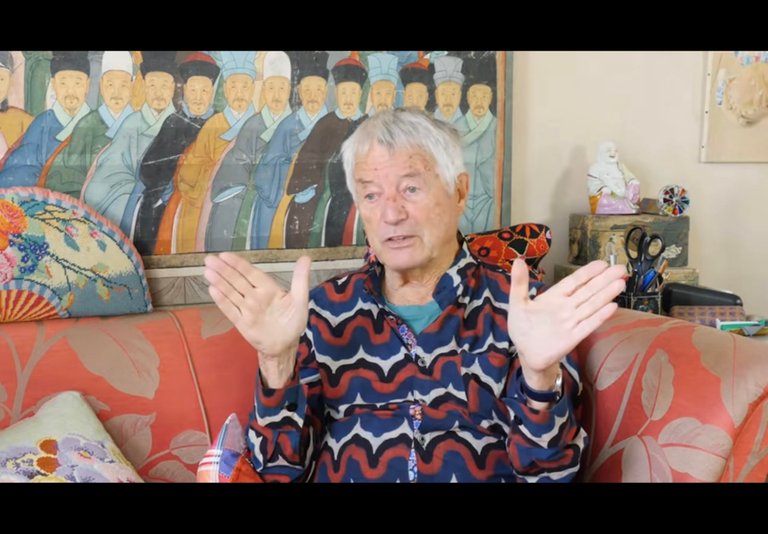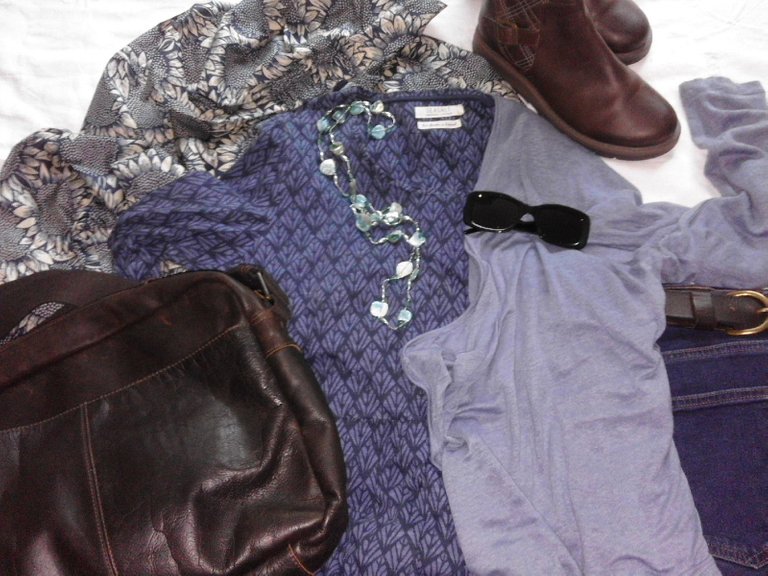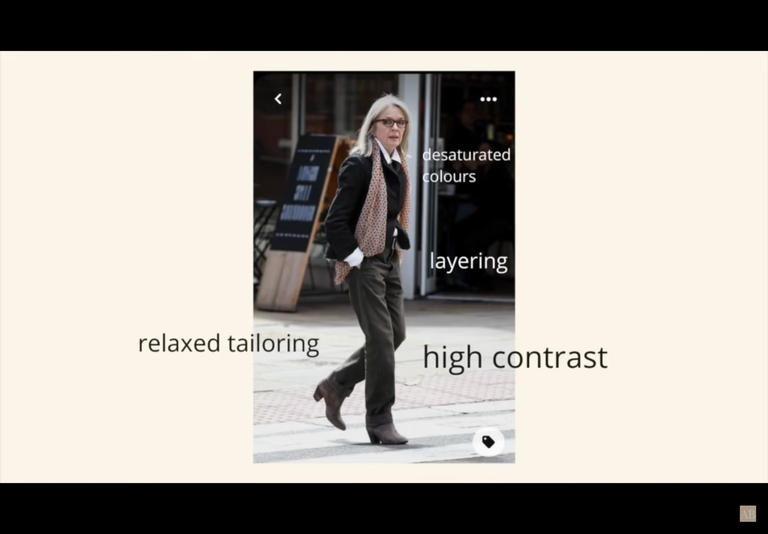I used to have a capsule wardrobe, back in the days when I was on the road, working in community venues, travelling between cities, bringing up a family. I would buy one or two pieces each season, filling gaps, replacing well-loved, well-used items, mainly in blues and greys with flashes of colour here and there. Everything was easy to wear, easy to maintain, easy to throw in a bag and go.
It was designed for a life in transit, moving from bus to train, everything I needed packed in one bag, layers and hoods and accessories enabling the same basic items to be worn year round, whatever the weather. Traipsing equipment up four flights of stairs, rescuing a toddler who had crawled under tables and couldn't find their way out, soothing a small baby while their mum joined in the group discussion about how to talk to teachers about the bullying their children were experiencing at school. A baby that left a little curdled milk sick on your shoulder. Then home, picking up a chicken and some greens on the way, and getting a meal for eight on the table, before throwing everything in the wash and starting again the next day.
I loved it. It was perfect. I had it down to a fine art.
Then came the pandemic and, at the same time, I went into an existential crisis about no longer having to work for a living. Like the world, I've come out the other side, and probably in a lot better shape than most of it.
I have a different wardrobe now. It is larger and evolving and it has grown from the streamlined get me through life but still look presentable when the Lady Mayor of Hammersmith and Fulham comes to visit your trans-generational social reporting project to something that is much more of a creative sandbox to draw on for capsules and outfits to suit my ever-changing moods for a life that is much more varied and has far fewer constraints.
My style is, Mr P says, urban. No other qualifying objectives. I have a hanging rack, some shelves for shoes and bags, accessories and a mending kit, another for sweatshirts, drawers with underwear and jersey items, folded and filed on their side, Marie Kondo-style, big, squash-y woollens in the deep chest at the bottom. Winter coats, boots and sportswear, are in the porch. Open a door, open a drawer, everything is there to see.
It still has the same blues and greys running through it, the bedrock, sprinkled with browns and blacks, burgundy and white and occasional flashes of red and duck egg. But now the profiles and textures have extended: still natural, low-maintenance fibres but greater diversity of shapes and combinations. Living in my own environment through the winter months, rather than in one paid for by someone else, I've learned how to wear multiple layers and still be able to move.

I have favourite pieces: a cerulean Tokyo Laundry hoodie, found by chance in T K Maxx. I have always loved it from the first day I clapped eyes on it, the colour, the labels and embroidery, the tabs on the drawstrings. It took me years to learn how to wear it, now it is like a second-skin.

From Kaffe Fassett - Part One by Fruity Knitting
I like being inspired by art. I'm intrigued by the colour palette in the painting behind Kaffe Fassett. In contrast to Kaffe's richly coloured, highly ornamented designs, I like the simple, rhythmic lines and muted colours. I'd enjoy seeing if I could create an outfit from my wardrobe with those elements.

Here is an example of an outfit from the pre-pandemic capsule wardrobe inspired by a 1932 abstract painting by Picasso (below). The necklace is for when the Lady Mayor comes by. In the winter, I would swap the rain mac for a woollen duffle coat and extra layers. It was more a uniform than a capsule - I could get dressed in the dark and know everything would go together.

Woman on the Beach, Pablo Picasso, 1932. This article about the Tate's Picasso Exhibition has a version with more vibrant colours.
Some YouTube bloggers are a great inspiration for being creative with what you have in your wardrobe. I enjoy Alyssa Beltempo's Shop your Closet series (every second Sunday of the month). This is how Alyssa describes what she does:
I find looks that I like online and I re-interpret them so that they suit my own style, my own body, and they use what I already have in my closet rather than shopping for them.

Here's an example with Diane Keaton from Alyssa's video about 70s style icons, suggested by viewers. You can see how Alyssa is analysing the look - relaxed tailoring, desaturated colours, layering and high contrast between the jacket and shirt. Alyssa shows her process of interpreting this look, why she chooses some garments and not others. The same video has an interpretation of Diana Ross, almost the diametric opposite of this one of Diane Keaton. All from the same wardrobe.
Just wondering if I could recreate those two looks from my wardrobe? 🤔 😁
One of my favourite places to shop is Oxfam online, which has a range of clothing and accessories, some vintage and others more contemporary. My best buys over the years have been coats and jackets, including a Barbour quilted biker jacket, two designer soft woollen blazers, and a brand new with tags (so never worn) 60s-style cropped tailored jacket. I do try charity shops but I tend to get overwhelmed: I find they are the pre-loved version of T K Maxx - some good bargains but you need to have had several weeks weight training, a good night's sleep and a hearty breakfast before you venture into them. A list helps, too.
There's a lot of discussion about what comprises a minimalist wardrobe. Is it thirty garments or is it buying what you need versus what you want? Or is it something else altogether? For me, it's not about precise numbers but more about values and attitudes. If you make your own clothes, you quickly become aware of what is involved, not only the cost of the materials but also the labour and skills that go into it. I want people to be paid fairly for the work they do, to work in safe conditions and to have the right to unionise. This would push the cost of garments up to a realistic price that took into account the human and environmental costs of creating them. I am not alone:
More than ever, sustainability is dominating consumer priorities and the fashion agenda. Consumers want to know where materials come from, how products are made, and whether the people involved are treated fairly. In response, more and more companies are expanding their sustainable assortments and working to boost the sustainability of their supply chains. As part of those efforts, some are leveraging digital product passports. These can be embedded in items to support after-use activities such as resale and recycling. Brands are also turning to passports, married with distributed-ledger technologies, in the battle against counterfeiting. State of Fashion 2022, McKinsey.
In my pre-pandemic life, my wardrobe was a pleasant, comfortable and practical arrangement that could tick all the boxes (workwear, leisure, weddings, funerals, court appearances) and stand up to the rigours of my lifestyle without a blink. It took very little time to manage or maintain. Now, with a change in lifestyle occasioned by both working arrangements and ageing, I have more time, skills and energy to invest in a wardrobe and it has expanded to fulfill more needs: creativity, self-care, self-expression (including values and principles), relaxation and downtime, fun.
I love the social opportunities it offers, too: swap shops or themed coffee mornings (maybe In Defence of Leopard Print or The Devil Wears DEPOP or Helenacore). I'm inspired by the young women defying the messages threatening to confine women to a tiny little physical and emotional space - I loved recreating "outfits I'll wear when I'm skinny" pinterest boards on a size 16: themes included big trousers, mini-skirts, matching sets and form-fitting dresses.
Again, wondering if I could recreate the looks from my wardrobe.
There are no florals in my wardrobe: stripes, checks, plaids and spots, but no florals. There is a limited colour palette and that really helps with organising to find and coordinate outfits. In addition to how I organise my hanging space and drawers, I store out of season clothes in vacuum bags. I like experimenting and dressing up - I love the downtime this creates. When I do buy something, I try to bring in new profiles that are not already in my wardrobe - different necklines, sleeve lengths, fabric textures - to create many options with few garments, rather than repeating things that are already there.
I like to set some limits: a budget for the year, I like saving for big items (coats and boots) and planning their purchase. I also limit storage space, everything has to fit comfortably into the spaces I've set aside. I'm a bit of a saver anyway, and a minimalist wardrobe appeals to my make do or do without mindset. Oh yes, having no buy months are really great for settling into your minimalist wardrobe and letting it mature.
I'm tagging @neumannsalva: Happy Birthday! I know you'll miss the deadline, but I thought you would enjoy the topic (we've discussed it so many times) 😍.
Join us for the Great Northern Hive Meet-Up: Halifax | Saturday 18 June | 12-5pm
Read the wonders here and here and book your place here.


Three things newbies should do in their first week and, for most things, forever afterwards!

